Companion Planting For Leeks
Leek (Allium ampeloprasum) is a cold-season vegetable that is related to the Allium family, family of garlic, onion, and shallots. Leeks are native to western Asia and the eastern Mediterranean region. Today leeks are grown in many parts of the world, including North and South America. They have a long, white cylindrical stalk that is the edible part of the plant.
The stalk is adorned with long tough and fibrous green leaves that are not edible. Leeks can be grown easily in the garden. While cultivating Leeks different varieties of plants can also be used in the garden for companion planting for leeks.
Leeks are a biennial plant, meaning they complete their life cycle in two years. In the first year, the leek plant will grow leaves and a bulb. In the second year, the leek plant will flower and produce seeds. However, they are typically harvested in the first year before they can flower. The Leek plant can grow up to 1-2 feet taller and wider. They have a milder flavor than onions and are harvested to be used in various dishes:
- Leaks add a delightful depth of flavor to the soups and stews.
- Thinly sliced leeks can add a touch of sweetness and savory goodness to stir fry mix.
- Raw or cooked thinly sliced leeks can be used in garnishing salad and soups adding a pop of flavor and color to them
- Moreover, they are a valuable source of vitamins A, C, and K along with fiber. They are relatively low in calories too.
Leeks are cool-season vegetables and survive under specific growth conditions. They require 6-8 hours of daily sunlight, but can also tolerate some shade, although it might affect the intensity of flavor. Leeks can withstand frost and even slightly cool weather.
They prefer well-drained soil and are not heavy feeders. Over-fertilizing can affect its production. Considering the growth habit of leeks one can select the most suitable companion plants for them in the garden.
What is Companion Planting?
To me, an empty garden is as bad as an empty heart. If I want to grow only Leeks in my garden it will not be beneficial for the health of the plant as well as soil. Planting a single crop in a place round the year and again and again, increases the chances of various diseases and depletion of nutrients in soil. That’s why different plants must be planted in the garden strategically in a definite pattern for successful gardening.
Companion planting involves a strategic approach in planting various varieties of plants altogether that help each other in pollination, pest control, nutritional management all without competing with each other. And the best part of companion planting is this technique provides an overfilled natural look to the garden rather than empty sad looking garden.
For more information about Kitchen Garden you can visit: Pumpkin Plant Life Cycle
There are different techniques of companion planting that one can prefer for leek plants such as:
- Trap Cropping
This technique involves planting different plants around the main plant to protect it from pests. Plant the companions around the perimeter of leeks or in alternating rows to create a sacrificial zone that lures pests away from the main valuable plant.
- Sometimes, pests target plants based on visual appearance. Choosing a trap crop that resembles your main crop can significantly take pest attention.
- Pests are often attracted or repelled by strong scents. Trapping the main crop inside a strong scented crop will make it invisible for pests.
- Planting a trap crop that matures faster can give it a head start in attracting pests before they reach the main crop.
Marigold, garlic, mustard greens and other herbs can be used in trap cropping.
- Guild Planting
This method involves creating a mini-ecosystem within the garden bed. This type of planting will create a beneficial relationship between plants that helps each other in the best growth.
- First of all the main plant is planted within the guild based on its size and need.
- Then, ground covers such as thyme and rosemary are added that will suppress weeds.
- Then flowering and relatively taller plants are added for shading purposes and attracting pollinators such as beans and sunflowers.
- Then the top layer is optionally added if additional shade is required or can also be planted as windbreak. For Example Maize.
- Vertical Planting
This is a space-saving strategy ideal for smaller gardens. As leeks are biennial plants they can be a good candidate for planting at the base of taller structures.
- Consider planting a climbing vegetable such as pole beans next to leeks.
- The beans will use the vertical space while leeks get the shade from very strong sunlight. However in optimum conditions, leeks prefer sunlight.
- Nitrogen Fixation Strategy
This is another technique for companion planting that helps to increase soil health. Although leek plants are not heavy feeders over-fertilizing affects their ability to develop strong flavor. However, if soil health is too poor, legumes such as peas can be planted that will help in nitrogen fixation with nitrogen-fixing bacterias in its root nodules.
These are just a few among the various types of companion planting for Leeks. Depending on specific goals, other plants being considered for the garden and the layout I am imagining, I will select the best approach for companion planting in my garden. Also checkout companion plants for tomatilo.
Benefits of Companion Planting
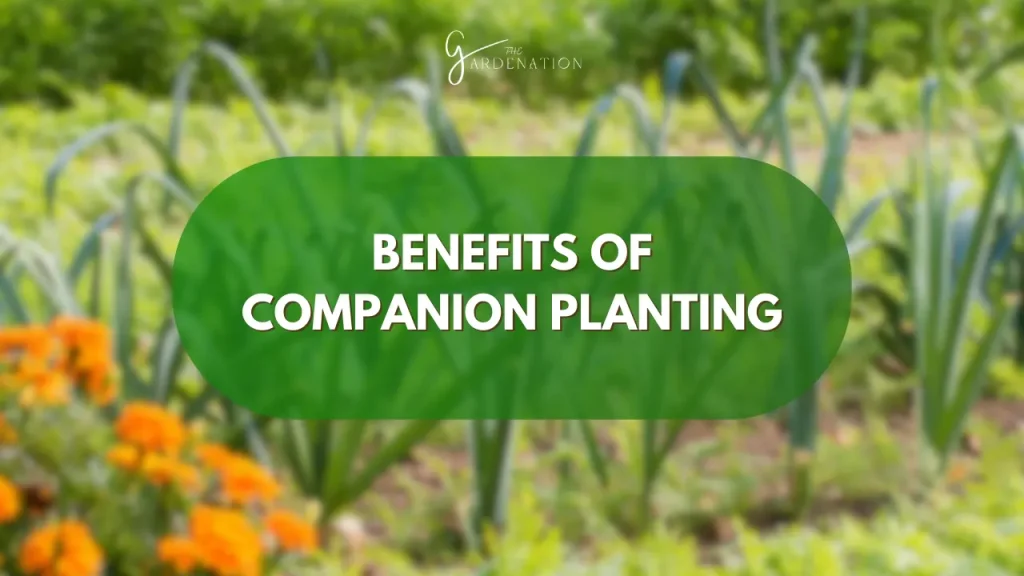
Companion planting hosts a wide range of benefits for Leek Plants, promoting a healthier and more productive garden. Some of these benefits are as follows.
Pest Control
Companion planting helps to reduce pests towards the leeks plant in various ways.
- Trap Cropping: Using sacrificial crops such as marigolds around leeks is trap cropping. Marigold attracts pests towards themselves, thus these pests such as aphids, and flea beetles pose all harm to it and leave the main crop unchecked.
- Repellent Odors: Using crops with a strong scent such as garlic and onion alongside or around the main crop will help to repel harmful pests from the garden. Their pungent smell interferes with the pheromones released by insects and confuses them. But leeks, garlic, and onion are related to the same family. So there is a chance that they will encourage similar diseases.
- Biocontrol: Using flowering plants for companion planting will attract beneficial insects such as ladybugs and wasps in the garden. These are natural predators and prey on harmful pests. In this way, companion planting helps our leeks plant through biocontrol.
The table below summarizes how some companion plants help leeks with pest control
| Companion Plant | Benefit for Leeks |
| Rosemary, Thyme | Repels cabbage moths, white flies |
| Carrots | Disrupt carrot fly navigation |
| Borage, Flowering Herbs | Attracts beneficial insects (lady bugs, hoverflies) |
| Corn | Provides shade, discourage heat-loving pests |
| Lettuce | Act as living mulch, suppresses weeds that harbor pests |
Improve Plant Growth and Yield
Companion planting through various mechanisms helps to improve the growth and yield of leeks.
- Nitrogen Fixation: Leguminous plants such as peas and beans have root nodules containing nitrogen fixing bacteria. Planting them in the garden enriches soil health and overall nourishes the health of nearby plants.
- Pollination: Flowering companion plants attract pollinators like bees and butterflies in the garden. These pollinators also enhance the pollination process in the main crop. Thus, they increase the overall yield in the garden.
- Shade and Support: Taller varieties such beans can be interplanted between leeks for shade in extreme hot climates. However, leeks under optimum conditions prefer full sun. Additionally they provide support to other vining and climber plants that are also intercropped between them.
Health and Biodiversity
- Improve Soil Quality: As described above certain nitrogen-fixing legumes enrich soil health and status. Similarly various other varieties contribute to increasing organic matter in plants. These overall benefits to the soil will ultimately flourish the growth of leek plants.
- Increase Biodiversity: Visuals are directly correlated to the feelings. Empty garden makes my heart feel empty, similarly a diverse garden with a variety of plants, hummingbirds and small insects makes me feel well. Thus companion planting enhances the ecosystem of a place as well as the mood of a person.
Various Companion Plants for Leeks
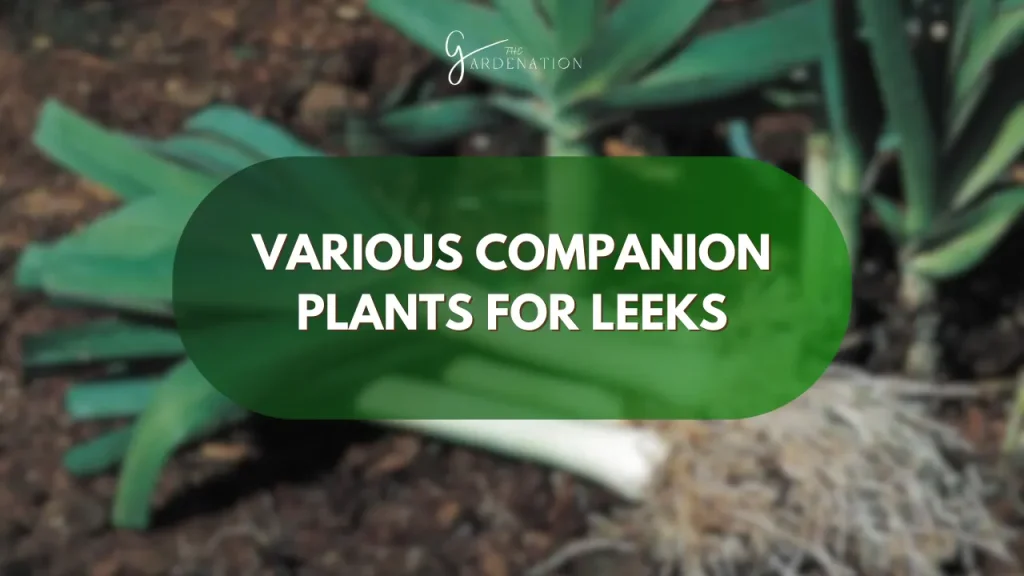
Vegetables and Fruits
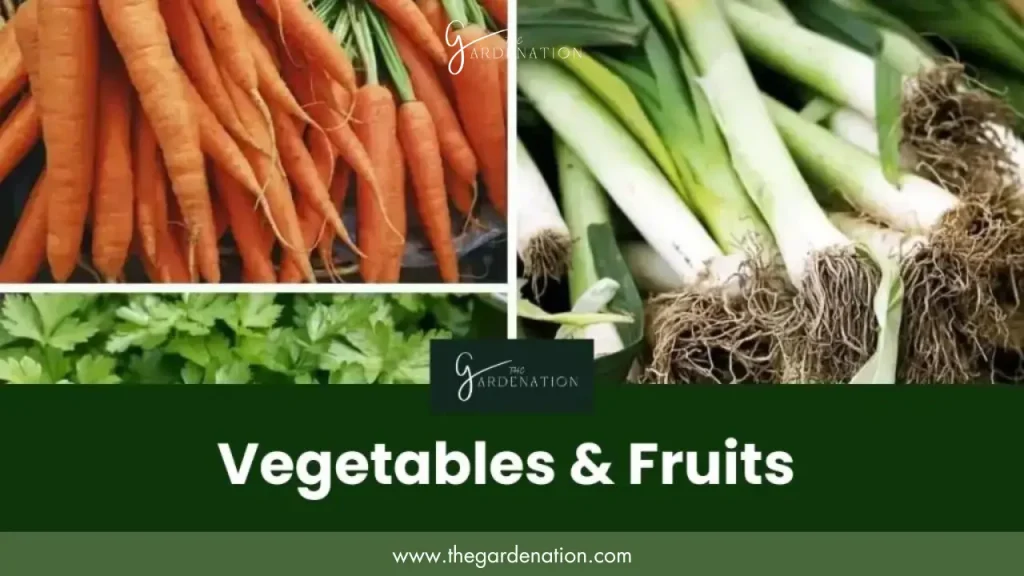
Vegetables and Fruits
- Carrots (Daucus carota)
These classic root vegetables come in various colors, most commonly orange and red. They have a long tapered body with blunt tip ends in a feathery green or purple top. The strong scent of leeks acts as a natural repellent for carrot flies, a major pest that targets carrot roots. Additionally, the feathery tops of carrots help to aerate the soil, creating a looser environment that promotes better root development for leeks.
- Celery (Apium graveolens)
This crunchy vegetable features a cluster of thick, green stalks with dark green, feathery leaves at the top. Leeks and Celery engage in a mutually beneficial partnership. Leeks with strong aroma, help deter celery leaf miners, tiny moth larvae that tunnel through celery leaves. Conversely, celery repels aphids, soft-bodied insects that suck sap from leeks.
- Beets (Beta vulgaris)
Beet is a vibrant root vegetable that comes in a variety of colors, most commonly deep purple or red. The tap root has a round or oblong shape with green leafy tops. Beets play a crucial role in improving soil drainage, which is essential for optimal leek growth. Leeks prefer well-drained soil to prevent root rot. Additionally, beets add valuable organic matter to the soil as they decompose, enriching it for future plantings.
- Strawberries (Fragaria x ananassa )
These delightful fruits boast a small, red heart-shaped form with a juicy, sweet interior and a green leafy cover. The pungent aroma of leeks acts as a natural deterrent for pests that commonly attack strawberries including weevils and certain beetles. This creates a protective zone for strawberries.
- Bush Melon (Cucumis melo)
These compact melons come in various shapes. Their sweet juicy flesh is perfect for a refreshing summer treat. Bush melons act as living mulch around leeks. Their crawling vines help suppress weeds that compete for resources and moisture.
- Climbing Beans (Phaseolus vulgaris)
Climbing beans are vining legumes that require support structures like trellises or poles. They produce long, slender green pods containing edible beans and have attractive green foliage. They provide double benefits for leeks. Firstly they fix nitrogen in the soil. Secondly, their climbing nature creates partial shade for leeks during hot weather.
- Peas (Pisum Sativum)
Climbing peas resembles the growth habit of climbing beans and needs support structure. They produce green pods containing small round edible seeds. Similar to climbing beans they are also good nitrogen-fixing plants and provide shade during hot weather. However, peas are quicker to mature than beans and are a good choice for a shorter growing season.
Herbs
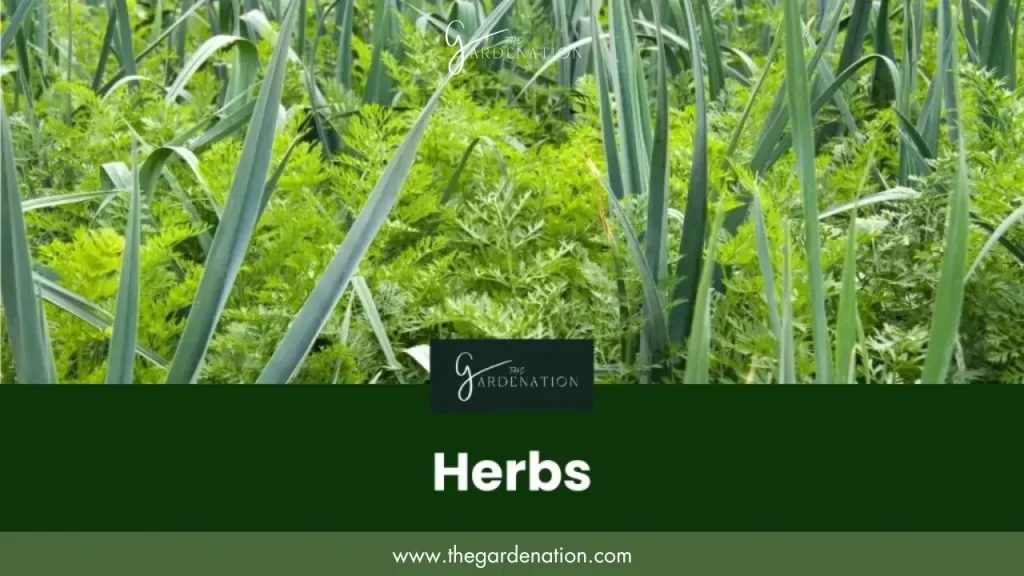
Herbs are considered good companions for Leek plants. Various herbs can be planted with Leeks such as.
- Rosemary- (Rosmarinus officinalis)
While rosemary prefers drier conditions than leeks, it is a good companion in well-drained soil. It also attracts pollinators and enhances the garden ecosystem. Rosemary itself is widely used in seasonings, marinades for meats and vegetables, and infused in oils. It is greatly important for its flavorful approach. In the field of medicine, rosemary is important for its anti-inflammatory effects. It is believed that rosemary enhances the flavor of leeks when planted nearby.
- Thyme- (Thymus vulgaris)
Thyme is another low-growing herb that can help suppress weeds around the leeks. Some thymes varieties like lemon thyme add a pleasant fragrance to the garden. It also attracts beneficial insects such as ladybugs and hoverflies that prey on harmful pests. Besides its various culinary importance that everyone is aware of, it is also a medicinal herb used to treat cough and sore throat, and wound healing and it also has antioxidant properties.
- Sage- (Salvia officinalis)
Sage are herbaceous plants that prefer growth conditions similar to leeks. Sage itself has various culinary and medicinal uses. In the field of medicine, it is believed to cure sore throat and digestive issues. In culinary it can be used in stuffings, seasoning and making sage butter. Various colorful varieties of sages are believed to attract pollinators like bees and butterflies in the garden, increasing the production of leeks and deter pests like aphids that may target leeks.
Flowering Companion Plants
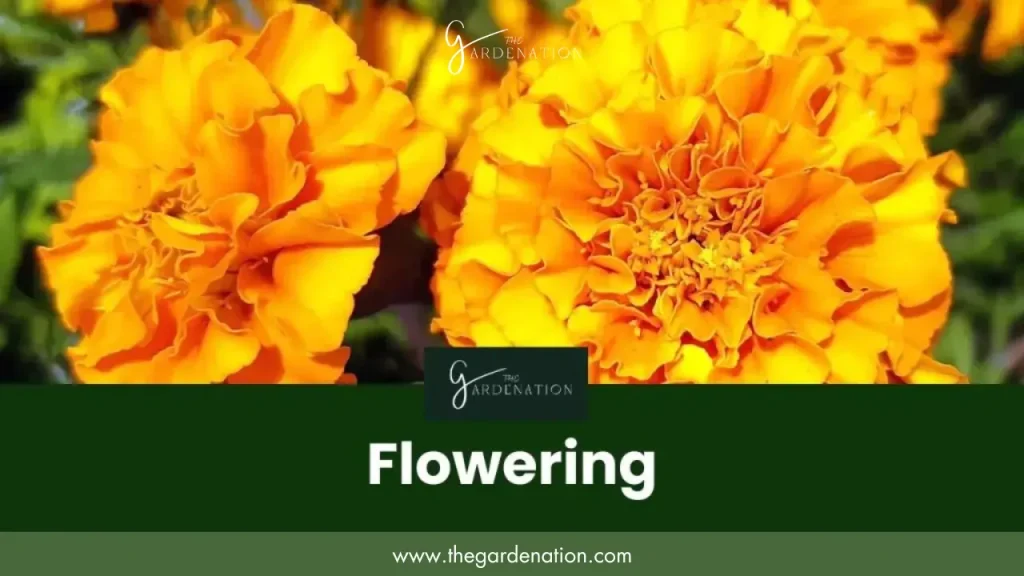
Flowering Companion Plants (Better Companion)
Flowers are considered a perfect companion plant. These flowering plants as a companion are greatly important, first for their aesthetic approach increasing the overall beauty of the garden. Secondly, they are known to attract pollinators that help in pollination for the main crop and enhance the overall ecosystem with hummingbirds and buzzing insects in the garden. Here I have enlisted a few plants that are most suited to leeks.
Borage (Borage Officinalis)
Borage boasts beautiful star-shaped blue flowers that bloom from early summer to fall. The fuzzy, heart-shaped leaves are also edible with a mild cucumber flavor. Borage as a companion plant is important for attracting pollinators like bees and butterflies, which can improve the pollination of leek flowers. It may also deter some pests affecting leeks.
Nasturtium (Tropaeolum majus)
Nasturtiums come in various colors like orange, yellow, and red with vibrant trumpet-shaped flowers throughout the summer. Both the flowers and leaves are edible with a peppery flavor. Its flowers attract pollinators and may act as a trap crop, attracting aphids away from leeks. They are also fast-growing and help to suppress weeds. These all attributes make it an excellent choice.
Calendula (Calendula officinalis)
Calendula are cheerful daisy-like flowers that come in shades of orange, yellow and sometimes white, blooming throughout the summer and fall. It is an important variety planted to deter soil-borne fungal diseases that can harm leeks and also act as a trap crop attracting harmful pests away from the main crop. The dried flowers can also be used for medicinal purposes.
Yarrow (Achillea millefolium)
Yarrow produces flat clusters of tiny white, pink or yellow flowers throughout the summer. The feathery leaves are also attractive. Yarrow attracts pollinators and is known for its ability to tolerate poor soil conditions.
This briefly introduces different plant varieties that can be used as companion plants with leeks. However one must consider proper spacing, sunlight needs and watering needs of the companion as well as main crop before planting and then plan the layout for the companion planting in the garden. If less plants are to be added than go for trap cropping and if one wants different types of plants with the main plant, one can plan a guild technique for the garden.
Frequently Asked Questions About Companion Planting For Leeks
How Long Does Leeks Take to Grow?
Leek plants are cool climate biennial plants that prefer full sun with moderate water conditions(not soggy). Being a biennial plant they take 2 years to mature fully. However, it is harvested in the first year of its growth stage. As in the second year, the plant undergoes a reproductive phase. But the main concern is its vegetative edible part that matures during the first half of its growth phase.
What are Bad Companions for Leeks?
Where there are several vegetables, herbs and fruits are good companions for leeks there are several bad companions too. These include onion, garlic, and shallots, belonging to the same family they share the same disease and pests thus can badly affect each other. Where the climbing bean variety is good, the bushy variety of beans is a bad companion as it may compete with leeks for resources.
Conclusion
Leeks are widely grown for their strong aroma and flavor that are known to enhance flavor and color of different delicacies. They are related to onion and garlic and share similar growth habits. In the garden leeks are an excellent addition and various other vegetables such as corn, beans, celery and herbs like thyme, sage and various flowers can be grown in their vicinity. These plants, if planted correctly, will benefit each other and protect each other from pests.

